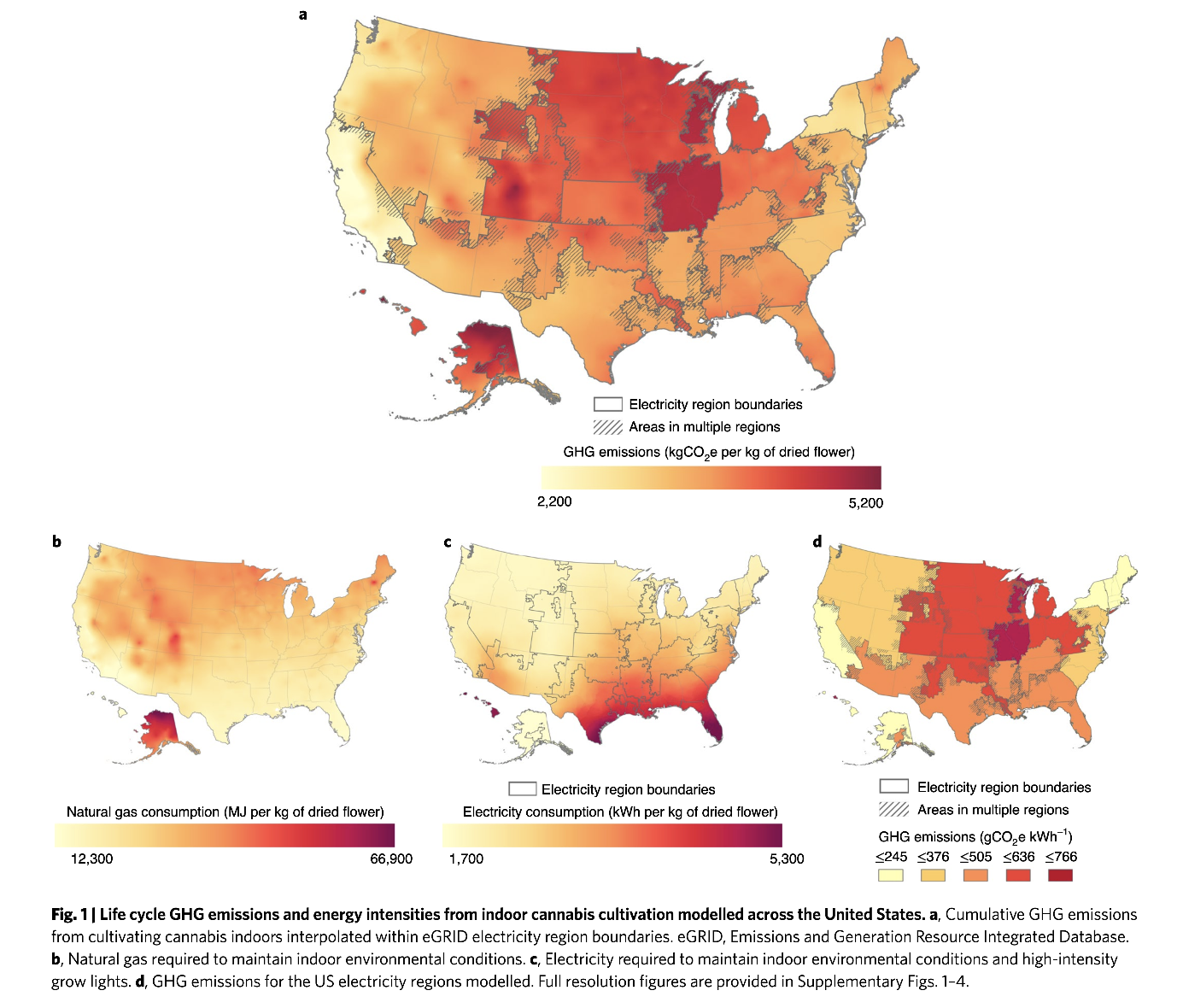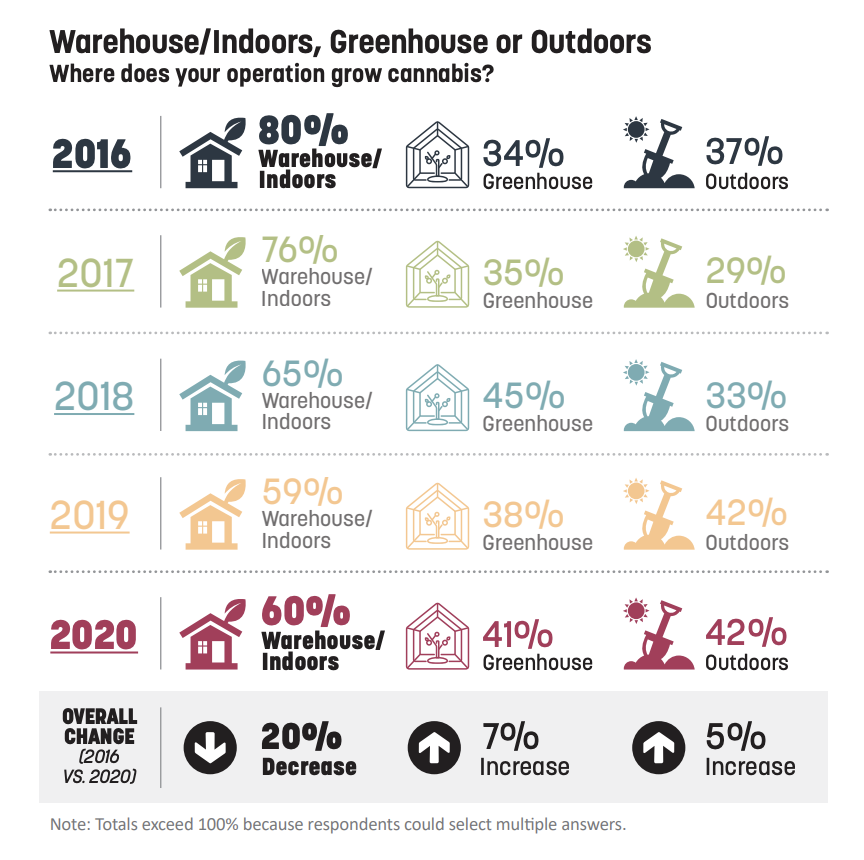A Look At The Environmental Impact Of The Cannabis Industry
Cannabis and Greenhouse Gas (GHG) Emissions
The cannabis industry is booming and with it comes huge financial winnings for those invested in the industry. Looking at this market from a financial, or even “health or self-improvement” standpoint, it is easy to think that society is benefiting from the growth and production of cannabis. And we would agree. Except for some of the environmental impacts.
There has been a lot in the news lately summarizing a recent paper in Nature Sustainability titled: “The Greenhouse Gas Emissions of Indoor Cannabis Production in the United States”*4. The following is a summary of these findings, what that means for the current state of growers, and what kind of steps should be taken to improve the current environmental impact of the industry.
It is important to note that this analysis provides a collection of data taken from indoor grows exclusively. After we summarize its findings, we will provide a case for why greenhouse growing, and specifically Ceres SunChamber™ growing, makes the most sense for reducing greenhouse gas (GHG) emissions.
The Current State of Affairs
The analysis from Nature Sustainability found that the largest source of emissions for indoor grows is from energy needed for maintaining the right balance of temperature and humidity, ventilation, air conditioning, and dehumidification (HVACD).
 *Summers, H.M., Sproul, E. & Quinn, J.C. The greenhouse gas emissions of indoor cannabis production in the United States. Nat Sustain (2021).
*Summers, H.M., Sproul, E. & Quinn, J.C. The greenhouse gas emissions of indoor cannabis production in the United States. Nat Sustain (2021).
While these environmental considerations vary depending on the geographic location of the facility, in every instance they still account for the majority of emissions per location.
 *Summers, H.M., Sproul, E. & Quinn, J.C. The greenhouse gas emissions of indoor cannabis production in the United States. Nat Sustain (2021).
*Summers, H.M., Sproul, E. & Quinn, J.C. The greenhouse gas emissions of indoor cannabis production in the United States. Nat Sustain (2021).
After HVACD, the largest factor contributing to GHG emissions is lighting, followed by supplemental CO2 (used to encourage plant growth).
Colorado cannabis produces around 2.6 million metric tons of CO2-equivalent annually. Just to put that in perspective, coal mining in the state produces 1.8 metric tons of CO2- equivalent, while waste management produces 4.2 million metric tons. Indoor cannabis represents 1.7% of the state’s GHG emissions*5.
Why Do Indoor Cultivation Emissions Matter?
Cannabis cultivation is on the rise. Without proper regulation, we could see a drastic rise in emissions. Because this is still such a new and developing industry, now is the time to influence the necessary regulations and policy that can set the standard moving forward.
So, How Are People Currently Growing? Isn’t There A Decrease In Indoor Cultivation?
Yes, growers are trending away from indoor growing. In 2020, 60% of growers were using indoor facilities. This is a 20% decrease since 2016. Meanwhile greenhouses have seen a 7% increase (from 34% to 41%)*3.
 *State of the Cannabis Cultivation Industry (Cannabis Business Times, 2020)
*State of the Cannabis Cultivation Industry (Cannabis Business Times, 2020)
A question posed from the Cannabis Business Times asked folks if they do not currently own a cultivation or work for an operation, but plan to grow in the next 2 years, what kind of facility would they opt for. 42% answered warehouse/indoors, while 49% said greenhouse, and 34% responded outdoors*3.
Bottom line: While people are still growing indoors, we are seeing a positive shift in the direction of both outdoor and greenhouse cultivation.
What’s Next With Indoor Cultivation?
The authors of the report recommend developing policy that helps both greenhouse and outdoor cultivation in order to reduce GHG emissions, and furthermore to avoid “…the practice of indoor cannabis cultivation altogether”.
“GHG emissions when switching to greenhouse and outdoor cultivation practices indicated reductions of 42 and 96%, respectively” *1,2.
The Case For A Ceres SunChamber™ (Or Greenhouse)
As discussed, greenhouses are a recommended strategy for the reduction of GHG emissions. Ceres’ sealed greenhouse solution, The SunChamber™, offers an even more advantageous solution to reducing emissions. The following are components of the greenhouse that help it do so.
The EcoLoop™:
The EcoLoop™ is a geothermal HVACD system designed specifically for the SunChamber™. As we have seen, the biggest contributor to GHG emissions is energy used for HVACD. This highly efficient heating, cooling, and dehumidification system can greatly reduce the need for excess emissions.
To learn more about this geothermal environmental control system, check out our blog, “Introducing the EcoLoop™: Ceres’ Most Energy-Efficient Heating and Cooling System Yet”.
The SunSense™ Controller:
Coupled with a more efficient and renewable energy source, the SunSense™ controller offers precise environmental control inside the greenhouse. The ability to pinpoint regulation of the environment ensures that excess energy is not used.
Check out our SunSense™ controller here
SunChamber™ As A Design:
The SunChamber™ in and of itself is designed to be a highly efficient, sealed facility. It is designed to maximize sunlight inside the growing environment, meaning energy used for lighting is dramatically reduced. And because it is sealed, energy-efficiency is maximized, as leakage is kept to a minimum.
Supplemental CO2 can also be used more efficiently with a sealed greenhouse, as ventilation necessitates continuous injection of CO2.
To read more about the benefits of a sealed greenhouse, please read our blog: 3 signs you should invest in a sealed cannabis greenhouse
We often make the case for the Ceres greenhouse facility solution on the grounds of saving money on operating costs, increasing yields, and increasing quality of product. Rarely do we make the case for the environment. Yet, the reality is that environmental costs are extremely important to consider. We must factor in externalities such as these whenever we consider a purchase/industry that has such huge impact. And as more studies are produced showing the negative effects that particular grows have on the environment, regulations will follow. We at Ceres are ready for the inevitable shift in policy.
References:
- The 2018 Cannabis Energy Report (New Frontier Data, 2018).
- O’Hare, M., Sanchez, D. L. & Alstone, P. Environmental Risks and Opportunities in Cannabis Cultivation (BOTEC Analysis Corporation, 2013).
- State of the Cannabis Cultivation Industry (Cannabis Business Times, 2020).
- Summers, H.M., Sproul, E. & Quinn, J.C. The greenhouse gas emissions of indoor cannabis production in the United States. Nat Sustain (2021).
- Heald, Sara. Colorado Greenhouse Gas Inventory. Colorado Department of Public Health & Environment (2019).